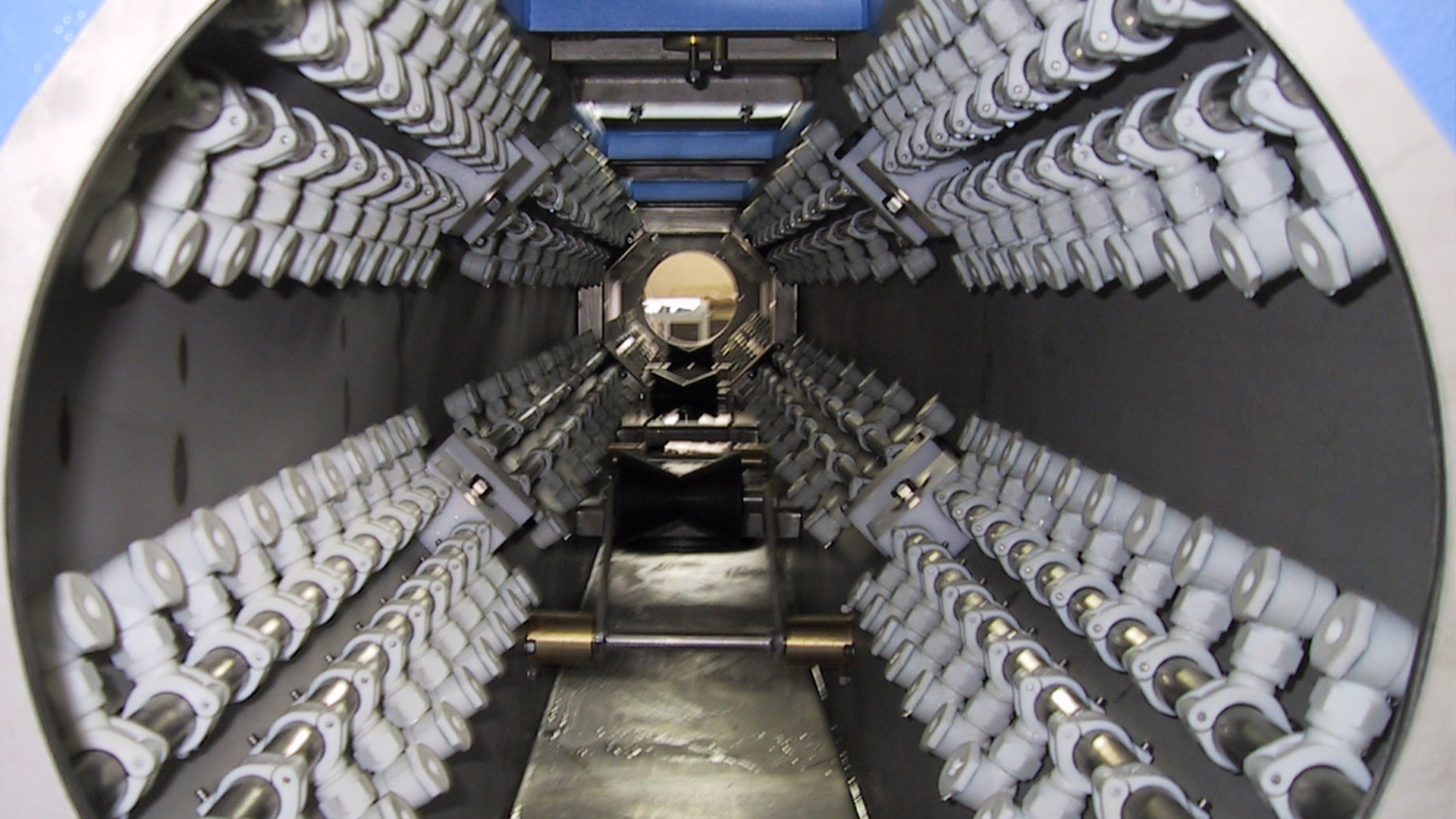
Vacuum and Cooling Tanks in Pipe Extrusion Lines
Vacuum and cooling tanks are crucial equipment used in pipe extrusion lines to rapidly and evenly cool the extruded hot pipe, stabilize its shape, and improve surface quality. These tanks ensure that the still-soft pipe acquires the desired properties at the final stage of the extrusion process.
Functions of Vacuum and Cooling Tanks
Rapid Cooling: When the hot extruded pipe enters the vacuum tank, it is quickly cooled by the sprayed cold water. This ensures even cooling of both the inner and outer surfaces of the pipe, reducing internal stresses and preventing warping.
Shape Stabilization: Rapid cooling helps to stabilize the shape of the pipe. Any deformations that may have occurred during extrusion are corrected during the cooling process.
Surface Quality: Water spraying during cooling removes surface imperfections, resulting in a smoother and more glossy surface.
Vacuum Application: The vacuum draws air from inside the pipe, eliminating voids in the inner surface and creating a denser structure.
Operating Principle of Vacuum and Cooling Tanks
Extrusion: The molten plastic is shaped into the desired form in a mold and exits as a pipe.
Entering the Cooling Tank: The hot pipe enters the cooling tank.
Cooling: Cold water is sprayed evenly onto all sides of the pipe from the spray nozzles inside the tank. Simultaneously, the vacuum system is activated to draw air from inside the pipe.
Exit of the Cooled Pipe: The cooled and shaped pipe exits from the other end of the tank and is sent to subsequent processes.
Importance of Vacuum and Cooling Tanks
Product Quality: Vacuum and cooling tanks play a significant role in the dimensional tolerances, surface quality, and mechanical properties of the produced pipes.
Efficiency: Rapid and effective cooling increases production speed and saves energy.
Product Variety: Different types of vacuum and cooling tanks can be used to produce pipes of various sizes and properties.
Selection of Vacuum and Cooling Tanks
The selection of vacuum and cooling tanks depends on factors such as the diameter, thickness, material, and desired cooling rate of the pipe to be produced. The size, material, number, and placement of spray nozzles are determined based on these factors.
In conclusion, vacuum and cooling tanks are indispensable equipment for producing high-quality and consistent pipes in pipe extrusion lines. By managing one of the most critical stages of the extrusion process, these tanks directly impact product quality.
In Extrusion Systems:
In an extrusion line, especially during the shaping of plastics, cooling ensures that the product hardens evenly and uniformly. At this point, spray nozzles are used for:
Cooling: Water sprays are used to rapidly cool the material after extrusion. This allows the product to take its desired shape.
Shape Correction: A smooth flow of liquid is provided to smooth out any imperfections on the surface of products such as plastic pipes or sheets.
Molding: Nozzles are used in the extrusion line to ensure that products form evenly on the mold.
In Vacuum Tanks:
Vacuum tanks are typically used to cool and smooth materials in a vacuum environment after the extrusion process. The spray nozzles used in this process have the following functions:
Surface Cleaning: Spray nozzles in the vacuum tank can clean moisture or dirt from the product's surface.
Liquid Distribution: They help to evenly distribute liquids in a vacuum environment, ensuring uniform cooling of the product.
Liquid Extraction: Spray nozzles in the vacuum tank quickly remove excess liquid from the surface, allowing for faster cooling of the product.
4. Nozzle Types and Applications
Fan-Type Nozzle:
Fan-type nozzles spray liquid over a wide area. This is particularly useful for evenly cooling large surfaces.
Application: Production of plastic sheets and films, cooling of large-surface products.
Conical Spray Nozzle:
Conical nozzles spread the liquid in a conical pattern, helping to cool products evenly.
Application: Pipe production, sheet production, cooling of profiles.
Flat Jet Nozzle:
Flat jet nozzles spray the liquid directly and intensively onto a specific area. This is often used for precise cooling and cleaning processes.
Application: High-precision surface finishing, cleaning, and cooling.
Spiral Jet Nozzle:
Spiral jet nozzles spread the liquid in a spiral pattern, providing uniform distribution over wide areas. They are particularly useful in vacuum tanks.
Application: Cooling in high flow rate applications, smoothing of plastic materials in vacuum tanks.
5. Material Selection and Durability
For long-lasting and efficient operation of spiral or fan-type nozzles, the choice of material is crucial. These nozzles are typically made from:
Stainless Steel (SS 304, SS 316): Offers high durability, corrosion resistance, and wear resistance. Suitable for hot environments and chemical liquids.
PVC and PVDF: Used in applications requiring chemical resistance. Generally low-cost and durable.
PTFE (Teflon): Offers superior resistance to chemical liquids and is compatible with abrasive fluids.
Aluminum: Lightweight and low-cost for specific applications, but susceptible to certain chemicals.












